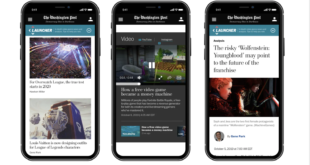IGN. Eurogamer. GameSpot. CVG. These are some of the biggest names in games media, all gracing the monitors of gamers the world over on a daily basis.
And yet, these giants are facing a new threat, as millions of gamers tune into Twitch and YouTube to get their games information.
While this might not mean the death of traditional journalism as some would have you believe, there has certainly been a shift in power.
So what is it about these video creators that’s causing such a change?
Video is such a powerful and immediate medium and so well suited to video games – both are inherently visual and social,” says Rich Keith, general manager of YouTube sensation Yogscast.
This is something that freelance video games journalist, and former Videogamer employee Matt Lees agrees with: Video is simply a better medium for explaining what games are like to play. You can convey a sense of how a game feels in writing, but being able to illustrate that with actual footage taken from a game is a formula that’s hard to beat.”
Of course, there are other reasons why video is interesting for today’s young gamers. In the case of Twitch, fans can interact live with the streamer via the chat box.
Written reviews are a one way broadcast to the end user without the chance to respond in real time,” explains Stuart Saw, regional manager for EMEA for Twitch. We enable interactivity which fuels the conversation in the community and enables viewers to help shape the review. In doing so they learn what they want to learn about the game before making purchasing decisions and that’s very powerful.”
There’s a generational issue, too. Most of these YouTube stars are younger than traditional journalists, and as a result may be more in tune with today’s huge teenage gaming audience.
Frustration has been building with more mainstream games sites when it comes to reviews,” comments Matthew Matosis, a YouTuber who has become famous in parts of the internet for his in-depth game reviews.
A lot of the time the tastes of the general players and the critics don’t seem to be in alignment. So it seems natural to me that they would seek out opinions elsewhere if they want to know whether a game is for them or not.”
Frustration has been building with more
mainstream games sites when it comes to
reviews. A lot of the time the tastes of the
general players and the critics don’t seem
to be in alignment. So it seems natural to
me that they would seek out opinions
elsewhere if they want to know whether
a game is for them or not.”
Matthew Matosis, YouTuber
YouTube personality Alistair Aiken, better known as Ali-A, says: ”Most viewers follow a YouTuber because they share similar interests or post video content on games that are enjoyed by the viewer.”
Matosis says one benefit to him is that he is not under the same commercial pressures to make regular videos as journalists are.
Reviewing things isn’t my day job so I’m under no obligation to produce videos quickly and my viewers often reassure me they value quality over quantity,” comments Matosis. I’m free to explore a game for as long as I like before I do a video on it. For my review of The Wonderful 101, I played the game more than four times but I’m still finding new mechanics and things to talk about so what hope does a reviewer have of picking up these things on a single playthrough?”
One of the criticisms of traditional games journalism is its pattern of previewing a title, reviewing it, before coverage stops so that journalists can cover other upcoming titles. Users on YouTube and Twitch find life in titles that traditional games media – until recently – may have forgotten.
Traditional media tends to cover games using the traditional PR cycle of reveal, preview, review, post-mortem. In most cases the review represents the resolution of a game’s coverage, allowing media to resume their coverage of new upcoming games,” comments Lees.
Twitch and YouTube users take a different approach: they have minimal access before a game’s release, and pick up their coverage after the media is mostly done. Media largely act as information gatekeepers, while streamers act as a part of the general conversation.”
This is something that Nathan Lindberg, Curse’s vice president of sales agrees with: What these new platforms do is mine the game for content that gamers need pre and post-launch.
For traditional publishers, once a game launches, it is effectively useless to them news wise as gamers can break down the information wall and get into the game.”
Of course, many outlets are adapting and now produce content post-review – CVG’s GTA 5 o’ Clock has been covering Rockstar’s crime title since it was released and reviewed in September.
Another advantage of YouTube and Twitch is that these outlets show off the game as it is – it’s not all carefully controlled pre-release trailers and preview footage.
People now use Twitch because in the past gamers had to gauge games based on slick, over-produced trailers akin to movie previews at the cinema,” explains Stuart Saw. With Twitch, gamers are able to see hours of gameplay and use that to make a better informed purchasing decision.”
So video is a better and more accurate way of showing off the latest games. Gamers can interact with it better. It’s more reflective of what young consumers want, and it doesn’t have to adhere to the PR cycle that the traditional games media has become trapped in.
So what hope is there for video game journalists?
IGN’s contributing editor and freelance journalist Keza MacDonald says that one of the advantages is the training, ethics and standards that are expected of them, which seperates her and her peers from independent creators.
Ideally, people working for media outlets should be trained, mentored and edited,” she says. YouTubers don’t have to conform to the journalistic ethics and standards that most established outlets enforce. And why should they need to? It’s entertainment.”
But Aiken says not having to follow the rules is an advantage to him: If journalists write an article on a game they have to follow certain guidelines, have it read over and edited by someone else before it is available to read. I have full freedom to present my video content in the way I want. As a result my personality comes through and my work is easy to tell apart from anyone else’s.”
This independence is arguably what makes many YouTubers so popular. YouTube personality Vikkstar123 says: YouTubers are definitely seen as more credible than corporations.”
But not all of these YouTube personalities are as independent as they might seem – and in fact come under the same pressures as many journalists.
Last month it was revealed that EA had made deals with YouTubers. Money changed hands for positive coverage of titles such as Battlefield 4. In traditional journalism, this sponsored content would typically be flagged up as advertorial or sponsored editorial.
Many argue that YouTubers are entertainers rather than journalists and because of that they can’t be held to account, but presenting products in a better light than they deserve in exchange for monetary gain represents a recommendation to your audience,” says Lees.
MacDonald adds: The only grey area for me in YouTube sponsorship is when it’s not declared. There should be greater transparency there – in TV entertainment, sponsorship is clearly stated.”
EA simply supported YouTubers that were postin

 MCV/DEVELOP News, events, research and jobs from the games industry
MCV/DEVELOP News, events, research and jobs from the games industry



